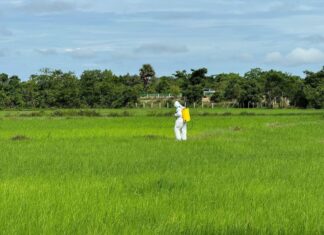Street-food sellers and residents say rising fish prices are steadily pushing some seafood out of financial reach for many, as advocates point to habitat destruction and plummeting fish stocks in natural lakes and rivers as driving up prices.
According to National Bank of Cambodia statistics, the price of fresh fish rose 8.8 percent in the year to March — the second-highest increase, behind dried fruit, out of 40 tracked categories.
Ly Nita, a street-food seller at a market in Russei Keo district, grills fish, pork and cooks rice and several dishes every day. The price of fish had been increasing faster than her other ingredients, she said, recently from about 9,000 riel per kg of trey deab, a type of catfish, to about 13,000 riel now, forcing her to raise her own prices. “My sale price is based on the price I pay in the market,” Nita said.
In her own family, the economic impact of coronavirus was putting a squeeze on her finances, she added. “My husband’s salary has been reduced to 50 percent for three months.”
A noodle-seller in Sihanoukville, Srey Anyy, said she had recently started giving discounts on her 6,000 riel ($1.50) bowls of num banh chok Khmer noodles, which contain fish, to people who have been struggling in the sluggish economy.
“I wish the price could come down,” Anyy said. “A lower price would be better for everyone.”
Shoppers echoed the concerns, saying some items were becoming difficult to afford.
Muy Chheng, a housewife with three children in Tuol Kork district, said she had seen the price of fresh fish from rivers and oceans increase beyond her reach despite her husband’s annual salary rises.
“I can’t buy the expensive foods,” Chheng said.
Bun Mech Thary, a housewife shopping in Russei Keo district, said she feels sorry for poorer families when she sees the prices in the market.
“I pity the poor people, and workers who cannot earn much — the price of food is quite high,” she said.
Homm Chan, a wholesale fish seller in Phnom Penh’s Kilometer 9 area, said he had seen a steady rise in fish prices over the past two years.
“River fish have become hard to find, and it makes some farmed fish prices increase as well,” Chan said.
Sellers from around the city buy their fish from him, and he moves about 3 tons on a normal day, he said. However, recent months had seen a decrease in sales of about 30 percent, he said.
Agriculture Minister Veng Sokhon told Newsroom Cambodia that fish prices naturally fluctuated, and nowadays most fish came from fish farms, which helped to lower prices.
The government supported a free market and it would not intervene in prices set by suppliers unless they became “too high,” he said.
Ek Chamroeun, project coordinator at the Fisheries Action Coalition Team, said fish farm prices were relatively stable but river fish were becoming increasingly endangered and expensive.
Illegal fishing — such as electrocution and using nets with a finer mesh than allowed — as well as climate change and the destruction of mangrove habitats were causing the number of fish to plummet, Chamroeun said.
He said Cambodia was currently in the middle of fish breeding season, until around the end of September, and it was vital to let fish stocks recover.
”We should collaborate together and not catch the fish during this breeding period — stop using all illegal tools and promote more awareness,” he said.












